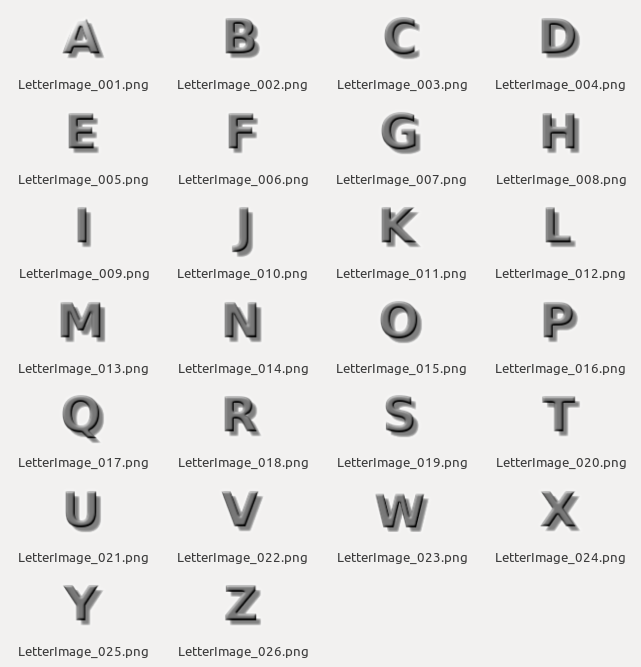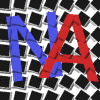An image of the linear alphabet isn’t going to do us much good so we need to split it down into individual letters.
Splitting Into Individual Letters:
To split this long image of the alphabet into individual characters I created a ‘bash'(linux) script. It uses the Image-Magick ‘convert’ program to do two things. First convert will compress the MxN image into a Mx1 (single pixel column) image and then report on the colors of the pixels in this image. The characters will be non-empty and the space around them will be empty (Color #00000000 RGBA). We just use the transition from one to the other to determine where the vertical extents of all the letters are and then use ‘convert’ to strip the excess non-character stuff off the top and bottom of the original image.
Then we do the same, compress the vertical dimension and strip out the characters from the trimmed image above. The individual characters are then saved in a directory by the name of the Alphabet strip image.
Here is the chopimage script that I use:
#
# Script file to chop an image of a string of characters into individual letters
# based on the uniform transparent background colour (=#00000000 none) between the letters.
#
# This script performs by taking the image and first using 'convert' to smoosh (a technical term)
# it down to a vertical image 1 pixel wide, then reporting on each of the pixels. An AWK command
# is used to look for a transition from 'none',or 'graya(0,0)'(the background) to something
# that isn't 'none' or 'graya(0,0)':
#
# ...
# 0,4: (0,0,0,0) #00000000 none
# 0,5: (0,0,0,0) #00000000 none
# 0,6: (0,0,0,0) #00000000 none
# 0,7: (0,0,0,0) #00000000 none
# 0,8: (3.63098e-09,1.45239e-08,0,5.62604e-15) #00000000 srgba(0,0,0,8.58478e-20)
# 0,9: (16191,64764,0,0.469211) #3FFC0000 srgba(63,252,0,7.15971e-06)
# 0,10: (16191,64764,0,9.36611) #3FFC0000 srgba(63,252,0,0.000142918)
# 0,11: (16191,64764,0,35.3837) #3FFC0000 srgba(63,252,0,0.000539921)
# 0,12: (16191,64764,0,96.4829) #3FFC0000 srgba(63,252,0,0.00147223)
# ...
# Or
# ...
# 41,0: (0,0) #00000000 graya(0,0)
# 42,0: (0,0) #00000000 graya(0,0)
# 43,0: (0,0) #00000000 graya(0,0)
# 44,0: (0,0) #00000000 graya(0,0)
# 45,0: (0,0) #00000000 graya(0,0)
# 46,0: (2.8607e-05,1.72444e-13) #00000000 graya(0,2.63133e-18)
# 47,0: (49575.3,21.5728) #C1C1C100 graya(193,0.000329179)
# 48,0: (49937.1,429.378) #C2C2C202 graya(194,0.00655189)
# 49,0: (51556.9,1516.96) #C9C9C906 graya(201,0.0231474)
# ...
#
# Awk then reports the line numbers which we use to determine where to cut the image (to get
# rid of most of the background. We again do this with 'convert'
#
# Next we do the same thing, smooshing the image down to a 1-pixel high image and using the
# resulting list (like above -- except for columns instead of rows) to tell us were to cut
# the letters out. We store these in a directory with the file name of the original image.
#
# The reported transitions from the background ('none') to otherwise is why we need expand the
# image in GIMP to make sure there is a boundary of blank space around the images (it will get
# trimmed off anyway).
#
# See article:
# https://stackoverflow.com/questions/33636849/imagemagick-split-image-by-background-color
#
# USAGE:
# chopimage <in-file.png> {"<out-file-fmt>" {<blank-width>}}
#
# Example:
# chopimage RoyalsGold.png "Letters_%03.png"
#
# NOTE: <blank-width> defaults to 50 pixels
#
# (Script created by alan on 12/Jun/2018 21:56:51)
#
pgm=chopimage
tmp=/tmp/${pgm}_
bin=/home/alan/bin
log=${bin}/data/${pgm}.$(uname -n).log
# Get our command line arguments making sure we have the original PNG file.
cmpimg=${1}
fmt=${2:-"CharImage_%03d.png"} # Default for format string
blank=${3:-50} # Default for blank width in pixels
if [ "$cmpimg" == "" ]; then
echo "USAGE: chopimage <compound-image> {<out-imgname-format>}"
exit
fi
# Strip the extension of the in-file-name and use that as output directory
dirnam=${cmpimg%.*}
# Display the working parameters
echo "cmpimg='$cmpimg'"
echo "fmt='$fmt'"
echo "blank='$blank'"
echo "dirnam='$dirnam'"
# Get the actual size of the image.
imgsz=$( file "$cmpimg" | sed "s/^.* \([0-9][0-9]*\) x \([0-9][0-9]*\),.*$/\1,\2/g" )
echo "imgsz='$imgsz'"
iszx=$( echo "$imgsz" | awk -F, '{ print $1 }' )
iszy=$( echo "$imgsz" | awk -F, '{ print $2 }' )
#echo "isz(x,y)=($iszx,$iszy)"
# Determine how much blank space we have on the top and bottom of the PNG. NOTE: We can't
# do this for individual characters like 'W' and '_' because our PLIST --> FNT conversion
# program isn't smart enough to orient different height characters verticaly.
# NOTE: This requires there to be blank space on the top AND bottom across the image, therefore,
# make sure your image has blank(transparent) areas on top and bottom.
echo "Finding top/bottom empty space"
convert ${cmpimg} -resize 1x! txt: >${tmp}tb1
cat ${tmp}tb1 \
| awk 'inside && /#00000000/{inside=0;print;next} !inside && ! /#00000000/{inside=1;print}' \
>${tmp}tb
# Get the line numbers of the top of the character and the bottom
echo "Getting y1,y2"
y1=$( head -3 ${tmp}tb | tail -1 | sed "s/^0,\([0-9][0-9]*\): .*$/\1/g" )
y2=$( tail -1 ${tmp}tb | sed "s/^0,\([0-9][0-9]*\): .*$/\1/g" )
echo "y1='$y1'"
echo "y2='$y2'"
# Add a little bit of padding (1 pixel top and bottom)
y1=$(( $y1 - 1 ))
szy=$(( $y2 - $y1 +2 ))
#echo "y1='$y1'"
#echo "szy='$szy'"
# Now actually do the vertical trimming
echo "Trimming top and bottom"
convert "${cmpimg}" -crop x${szy}+0+${y1} "${tmp}.png"
# Now we can do the same procedure with the horizontal divisions (except there are more of them).
# NOTE: This requires there to be blank space on the Left AND Right sides of the image, therefore,
# make sure your image has blank(transparent) areas on the sides.
echo "Finding inter-letter spacing"
convert "${tmp}.png" -resize x1! txt: >${tmp}bnd1
cat ${tmp}bnd1 \
| awk 'inside && /#00000000/{inside=0;print;next} !inside && ! /#00000000/{inside=1;print}' \
>${tmp}bnd
# Create the output directory
mkdir -p "${dirnam}" 2>/dev/null
imgno=1 # Counter for output image number.
gotblank=0 # Flag indicating whether we've created the blank character yet.
lastx2=0 # Counter to get inter-character spacing for blank character.
# Now do the actual cutting off of characters
cat ${tmp}bnd |\
while read line1
do
# Look for the LHS record for the current character
echo "$line1" | grep "rgba(\|graya([1-9]" >/dev/null
if [ $? -eq 0 ]; then
# We've found it so read in the next record which will be the RHS-record.
read line2
echo "--------------------------"
echo "line1='$line1'"
echo "line2='$line2'"
# Calculate the pixel extents of the current character.
x1=$( echo "$line1" | sed "s/,.*$//g" )
x2=$( echo "$line2" | sed "s/,.*$//g" )
# Check to see if we have processed the blank character yet.
if [ $gotblank -eq 0 ]; then
# Find the distance from the RHS of the last character to the LHS of the current char.
dlx2x1=$(( $x1 - $lastx2 ))
# If it is big enough for a blank then produce the file.
if [ $dlx2x1 -ge $blank ]; then
echo "Producing blank character, $blank pixels wide"
# Generate the output file name and create a blank.png from this space
fname=$( printf $fmt $imgno )
convert "${tmp}.png" -crop ${blank}x+${lastx2}+0 "${dirnam}/${fname}"
# Increment our image number.
imgno=$(( $imgno + 1 ))
gotblank=1
fi
else
echo "Already got blank"
fi
lastx2=$x2
# Display the coordinates of the character to output.
echo "x1,x2='$x1,$x2'"
#x1p=$(( $x1 - 1 ))
# Determine the character x-metrics.
x1p=$x1
szx=$(( $x2 - $x1 ))
# Create the character file name and extract the bitmap to the given file.
fname=$( printf $fmt $imgno )
convert "${tmp}.png" -crop ${szx}x+${x1p}+0 "${dirnam}/${fname}"
echo "Producing character: $fname"
# On to the next image ...
imgno=$(( $imgno + 1 ))
fi
done
#
# end of 'chopimage' script file.
#
Just run the program with the image name and if you want a different width for your space character (default=50 pixels) then specify this too. My PNG file was called GradientBevel.png, I wanted 40pixel wide spaces and I wanted the output image files to be named “LetterImage_%03d.png” so my command was:
chopimage GradientBevel.png “LetterImage_%03d.png” 40
This produced the following output:
cmpimg='GradientBevel.png'
fmt='LetterImage_%03d.png'
blank='40'
dirnam='GradientBevel'
imgsz='1453,103'
Finding top/bottom empty space
Getting y1,y2
y1='27'
y2='89'
Trimming top and bottom
Finding inter-letter spacing
--------------------------
line1='16,0: (65535,65535,65535,0.98363) #FFFFFF00 srgba(255,255,255,1.50092e-05)'
line2='70,0: (1.61668e-09,1.61668e-09,1.61668e-09,1.85662e-15) #00000000 srgba(0,0,0,2.83302e-20)'
x1,x2='16,70'
Producing character: LetterImage_001.png
--------------------------
line1='76,0: (65535,65535,65535,17.1694) #FFFFFF00 srgba(255,255,255,0.000261989)'
line2='122,0: (2.10696e-08,2.10696e-08,2.10696e-08,1.41067e-14) #00000000 srgba(0,0,0,2.15254e-19)'
x1,x2='76,122'
Producing character: LetterImage_002.png
--------------------------
line1='129,0: (65535,65535,65535,4.98295) #FFFFFF00 srgba(255,255,255,7.60349e-05)'
line2='176,0: (4.59765e-08,4.59765e-08,4.59765e-08,3.01553e-14) #00000000 srgba(0,0,0,4.6014e-19)'
x1,x2='129,176'
Producing character: LetterImage_003.png
--------------------------
line1='185,0: (65535,65535,65535,17.1694) #FFFFFF00 srgba(255,255,255,0.000261989)'
line2='235,0: (4.08064e-08,4.08064e-08,4.08064e-08,2.64424e-14) #00000000 srgba(0,0,0,4.03485e-19)'
x1,x2='185,235'
Producing character: LetterImage_004.png
--------------------------
line1='244,0: (65535,65535,65535,17.1694) #FFFFFF00 srgba(255,255,255,0.000261989)'
line2='286,0: (1.99955e-08,1.99955e-08,1.99955e-08,-1.33887e-14) #00000000 srgba(0,0,0,-2.04299e-19)'
x1,x2='244,286'
Producing character: LetterImage_005.png
--------------------------
line1='295,0: (65535,65535,65535,17.1694) #FFFFFF00 srgba(255,255,255,0.000261989)'
line2='336,0: (1.86687e-08,1.86687e-08,1.86687e-08,-1.25011e-14) #00000000 srgba(0,0,0,-1.90755e-19)'
x1,x2='295,336'
Producing character: LetterImage_006.png
--------------------------
line1='344,0: (65535,65535,65535,4.98295) #FFFFFF00 srgba(255,255,255,7.60349e-05)'
line2='395,0: (5.95701e-08,5.95701e-08,5.95701e-08,-3.61643e-14) #00000000 srgba(0,0,0,-5.51831e-19)'
x1,x2='344,395'
Producing character: LetterImage_007.png
--------------------------
line1='404,0: (65535,65535,65535,17.1694) #FFFFFF00 srgba(255,255,255,0.000261989)'
line2='453,0: (1.19024e-07,1.19024e-07,1.19024e-07,-7.01002e-14) #00000000 srgba(0,0,0,-1.06966e-18)'
x1,x2='404,453'
Producing character: LetterImage_008.png
--------------------------
line1='463,0: (65535,65535,65535,17.1694) #FFFFFF00 srgba(255,255,255,0.000261989)'
line2='488,0: (1.19024e-07,1.19024e-07,1.19024e-07,-7.01002e-14) #00000000 srgba(0,0,0,-1.06966e-18)'
x1,x2='463,488'
Producing character: LetterImage_009.png
--------------------------
line1='492,0: (65535,65535,65535,3.12778) #FFFFFF00 srgba(255,255,255,4.77269e-05)'
line2='524,0: (1.28439e-07,1.28439e-07,1.28439e-07,-7.54638e-14) #00000000 srgba(0,0,0,-1.1515e-18)'
x1,x2='492,524'
Producing character: LetterImage_010.png
--------------------------
line1='535,0: (65535,65535,65535,17.1694) #FFFFFF00 srgba(255,255,255,0.000261989)'
line2='587,0: (1.61668e-09,1.61668e-09,1.61668e-09,-1.85662e-15) #00000000 srgba(0,0,0,-2.83302e-20)'
x1,x2='535,587'
Producing character: LetterImage_011.png
--------------------------
line1='591,0: (65535,65535,65535,17.1694) #FFFFFF00 srgba(255,255,255,0.000261989)'
line2='633,0: (1.99955e-08,1.99955e-08,1.99955e-08,-1.33887e-14) #00000000 srgba(0,0,0,-2.04299e-19)'
x1,x2='591,633'
Producing character: LetterImage_012.png
--------------------------
line1='640,0: (65535,65535,65535,17.1694) #FFFFFF00 srgba(255,255,255,0.000261989)'
line2='697,0: (1.19024e-07,1.19024e-07,1.19024e-07,-7.01002e-14) #00000000 srgba(0,0,0,-1.06966e-18)'
x1,x2='640,697'
Producing character: LetterImage_013.png
--------------------------
line1='707,0: (65535,65535,65535,17.1694) #FFFFFF00 srgba(255,255,255,0.000261989)'
line2='756,0: (1.19024e-07,1.19024e-07,1.19024e-07,-7.01002e-14) #00000000 srgba(0,0,0,-1.06966e-18)'
x1,x2='707,756'
Producing character: LetterImage_014.png
--------------------------
line1='764,0: (65535,65535,65535,4.98295) #FFFFFF00 srgba(255,255,255,7.60349e-05)'
line2='817,0: (4.78058e-08,4.78058e-08,4.78058e-08,-3.04409e-14) #00000000 srgba(0,0,0,-4.64499e-19)'
x1,x2='764,817'
Producing character: LetterImage_015.png
--------------------------
line1='826,0: (65535,65535,65535,17.1694) #FFFFFF00 srgba(255,255,255,0.000261989)'
line2='872,0: (2.50286e-08,2.50286e-08,2.50286e-08,-1.68538e-14) #00000000 srgba(0,0,0,-2.57173e-19)'
x1,x2='826,872'
Producing character: LetterImage_016.png
--------------------------
line1='878,0: (65535,65535,65535,4.98295) #FFFFFF00 srgba(255,255,255,7.60349e-05)'
line2='931,0: (4.78058e-08,4.78058e-08,4.78058e-08,-3.04409e-14) #00000000 srgba(0,0,0,-4.64499e-19)'
x1,x2='878,931'
Producing character: LetterImage_017.png
--------------------------
line1='940,0: (65535,65535,65535,17.1694) #FFFFFF00 srgba(255,255,255,0.000261989)'
line2='989,0: (1.61668e-09,1.61668e-09,1.61668e-09,-1.85662e-15) #00000000 srgba(0,0,0,-2.83302e-20)'
x1,x2='940,989'
Producing character: LetterImage_018.png
--------------------------
line1='995,0: (65535,65535,65535,7.3013) #FFFFFF00 srgba(255,255,255,0.000111411)'
line2='1040,0: (7.78376e-08,7.78376e-08,7.78376e-08,-2.84178e-14) #00000000 srgba(0,0,0,-4.33628e-19)'
x1,x2='995,1040'
Producing character: LetterImage_019.png
--------------------------
line1='1045,0: (65535,65535,65535,2.85368) #FFFFFF00 srgba(255,255,255,4.35443e-05)'
line2='1094,0: (7.46746e-08,7.46746e-08,7.46746e-08,-2.50023e-14) #00000000 srgba(0,0,0,-3.8151e-19)'
x1,x2='1045,1094'
Producing character: LetterImage_020.png
--------------------------
line1='1100,0: (65535,65535,65535,12.1229) #FFFFFF00 srgba(255,255,255,0.000184983)'
line2='1147,0: (3.82292e-07,3.82292e-07,3.82292e-07,-1.13423e-13) #00000000 srgba(0,0,0,-1.73072e-18)'
x1,x2='1100,1147'
Producing character: LetterImage_021.png
--------------------------
line1='1154,0: (65535,65535,65535,0.772458) #FFFFFF00 srgba(255,255,255,1.17869e-05)'
line2='1208,0: (5.96768e-09,5.96768e-09,5.96768e-09,-3.42669e-15) #00000000 srgba(0,0,0,-5.2288e-20)'
x1,x2='1154,1208'
Producing character: LetterImage_022.png
--------------------------
line1='1211,0: (65535,65535,65535,0.772458) #FFFFFF00 srgba(255,255,255,1.17869e-05)'
line2='1279,0: (2.72452e-08,2.72452e-08,2.72452e-08,-1.21862e-14) #00000000 srgba(0,0,0,-1.8595e-19)'
x1,x2='1211,1279'
Producing character: LetterImage_023.png
--------------------------
line1='1283,0: (65535,65535,65535,0.98363) #FFFFFF00 srgba(255,255,255,1.50092e-05)'
line2='1335,0: (6.46671e-09,6.46671e-09,6.46671e-09,-3.71324e-15) #00000000 srgba(0,0,0,-5.66605e-20)'
x1,x2='1283,1335'
Producing character: LetterImage_024.png
--------------------------
line1='1338,0: (65535,65535,65535,2.69423) #FFFFFF00 srgba(255,255,255,4.11113e-05)'
line2='1390,0: (5.96768e-09,5.96768e-09,5.96768e-09,-3.42669e-15) #00000000 srgba(0,0,0,-5.2288e-20)'
x1,x2='1338,1390'
Producing character: LetterImage_025.png
--------------------------
line1='1393,0: (65535,65535,65535,6.36067) #FFFFFF00 srgba(255,255,255,9.70577e-05)'
line2='1440,0: (1.41726e-07,1.41726e-07,1.41726e-07,-4.80423e-14) #00000000 srgba(0,0,0,-7.33078e-19)'
x1,x2='1393,1440'
Producing character: LetterImage_026.png
This left me with a directory full of letter images. Note: if some of your letters are packed together into one image increase the spacing between these letters in the alphabet string above and redo all the intervening work. These are the letter images in one of my font directories:

You may notice looking at your individual character files that there seems to be a lot of space surrounding certain letters. This may be due to an included underscore (or some similar character) that forces a vertical trimming that isn’t optimal for all characters. However, this will make it easier to position the characters in Cocos2d-x.
Problems:
I’ve tripped across a few problems. Here are their solution/explanations:
- Whitespace on individual letters seems excessive. This may be due to one or more characters in the alphabet extending beyond the average characters boundaries. For instance I found an underscore ‘_’ character cause all my letters to have excess white-space at the bottom. Eventually I’ll make my PList->Fnt translation program smart enough to adjust the position of the letters based on their actual extent … but until then.
- Multiple letters in individual letter files. This is due to two sequential letters coming too close together in the image (because of glow/drop-shadow or kerning) and can be solved by putting more blanks between characters in the alphabet string.
- No results at all. I’ve found this is because there is not enough color #00000000 (empty) boundary around the letters. In gimp just increase the canvas size (and center the image) and this should fix the problem.
Next:
OK, now that we’ve split them all apart we have to put them all back together into a sprite sheet.
